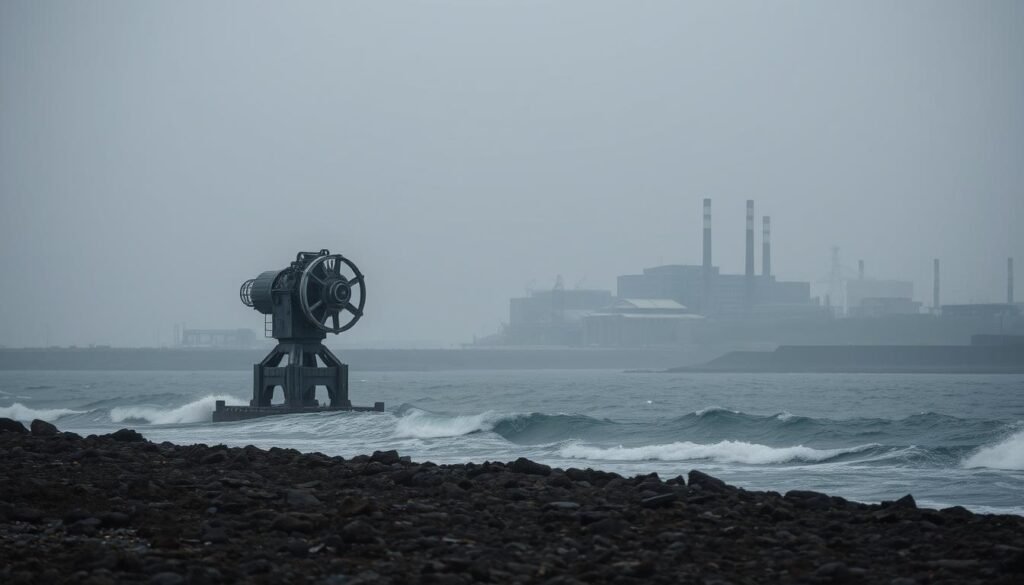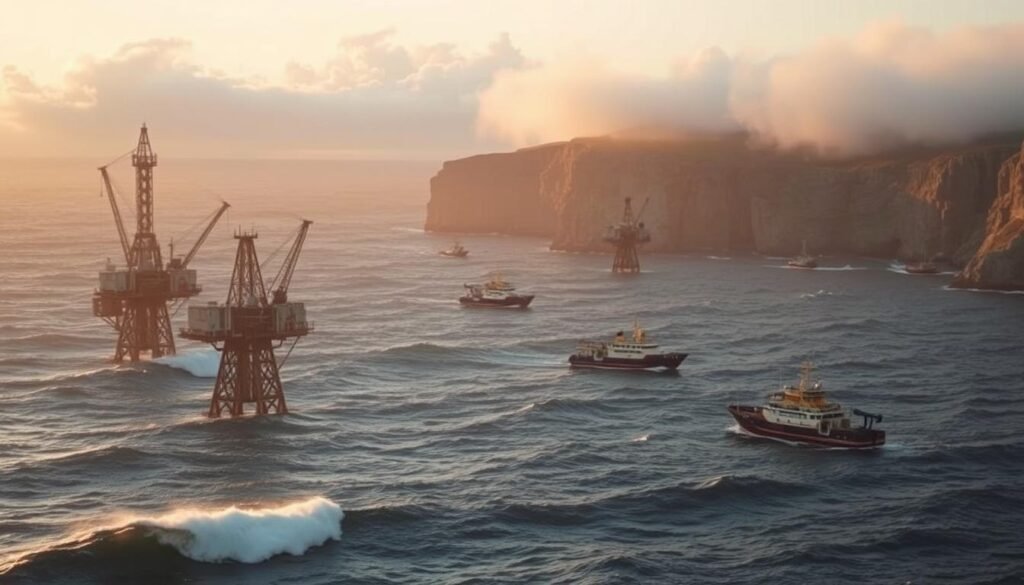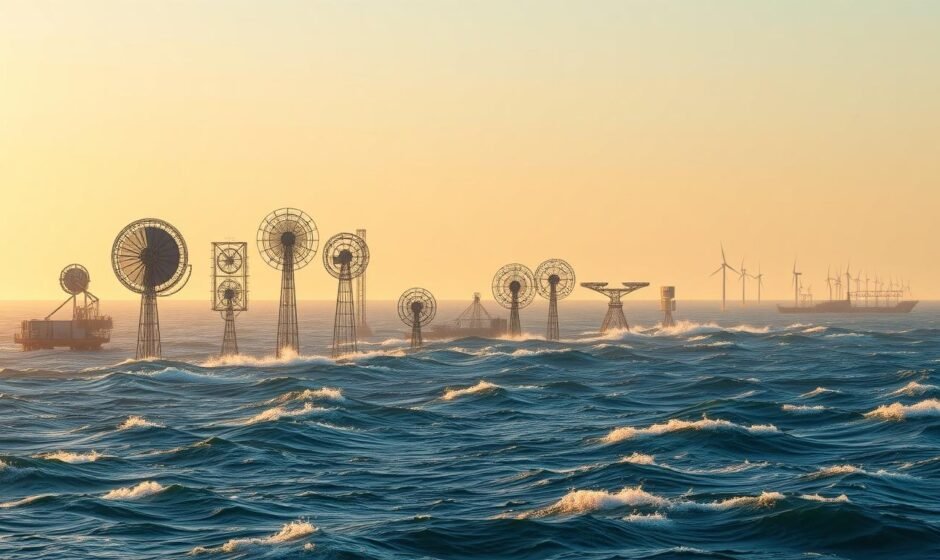Stephen Hawking once said, “The universe has no beginning and no end, but our planet does, and it is up to us to take care of it.” You can help save the planet by using renewable energy like tidal power. Tidal energy is clean and can power millions of homes. It’s a huge source of power, with 3,000 gigawatts available.
There are different ways to use this energy, like tidal stream generators and tidal barrages. These technologies help us use the ocean’s power.
Tidal energy is reliable, with two cycles every 24 hours and 50 minutes. It’s also cheaper to run than fossil fuels because it has fewer parts and no fuel costs. Using tidal energy means less pollution and a smaller carbon footprint.
It can work during both high and low tides, making more power. By choosing tidal energy, you’re helping the planet and its future.
Key Takeaways
- Tidal energy is a renewable source of energy that harnesses the power of the ocean’s tides to generate electricity.
- Tidal energy generation methods include tidal stream generators, tidal barrages, and tidal lagoons.
- The total amount of energy contained in the world’s tides is 3,000 gigawatts.
- Tidal energy provides a predictable output with two tidal cycles occurring approximately every 24 hours and 50 minutes.
- Tidal energy systems can generate power outputs both during incoming and outgoing tides, increasing energy generation.
- Tidal energy can create ecological changes in estuary ecosystems, influencing sediment buildup and wildlife navigation.
What Is Tidal Energy and How Does It Work?
Tidal energy comes from the ocean’s tides, which move up and down. This movement is caused by the Earth, moon, and sun’s gravitational pull. You can find out more about ocean renewable energy and its role in our energy supply.
The science behind tidal energy is fascinating. It uses special generators to capture the tides’ energy. This energy is then turned into electricity, making it a key part of ocean renewable energy.
Places like the Rance River estuary in France and the Strangford Lough power station in Northern Ireland show tidal energy’s power. These examples highlight its ability to help meet our energy needs.
Tidal energy is a green and lasting power source. Yet, it faces challenges like high setup costs and limited places to use it. As technology improves, we’ll see better and cheaper ways to use wave power systems for ocean renewable energy.
The Different Tidal Energy Generation Methods
Tidal energy comes in two main types: flow devices and surface height change devices. Hydrokinetic turbines are a key part of flow devices. They capture the kinetic energy of tidal streams, providing clean power. This makes tidal energy a reliable and attractive option for investors.
Some of the key methods of tidal energy generation include:
- Tidal stream systems, which use underwater turbines to capture the kinetic energy of the tides
- Tidal barrage technology, which uses a dam-like structure to harness the energy of the tides
- Tidal range solutions, which involve building a barrier across a tidal estuary to capture the energy of the rising and falling tide
Each method has its own benefits and drawbacks. For instance, tidal stream systems are cheaper to install and maintain. Yet, they might not be as efficient as other methods. Tidal barrage technology can produce more power but can harm the environment.
When it comes to efficiency, tidal stream power uses different turbine designs. Shrouded turbines and open rotor turbines are common. Shrouded turbines are more efficient, making them a top choice for tidal energy projects. As technology advances, we’ll see even better designs, boosting tidal energy’s power.
Advantages of Tidal Energy Generation
Tidal energy generation has many benefits, making it a great choice for a green future. By investing in sustainable marine energy like tidal power, you help the planet. Tidal barrage systems can make a lot of electricity, cutting down on fossil fuel use.
Some key benefits of tidal energy include:
- Renewable and sustainable power source
- Energy reliability and consistency
- Low environmental impact
When you think about investing in tidal energy, remember it’s a big step against climate change. Tidal energy is reliable and constant, perfect for a green economy.
Using tidal energy helps make our future cleaner and greener. It can lower greenhouse gas emissions and boost energy freedom. Tidal energy is a thrilling new area in renewable energy.
Disadvantages of Tidal Energy Generation
When looking into renewable energy, it’s key to know the good and bad of tidal power. Tidal energy is a promising new way to get power, but it has big downsides. The biggest issue is the high cost to start a tidal energy project. For example, the Sihwa Lake Tidal Power Station cost around $560 million to build.
Another big problem is how tidal energy might harm the environment. Electro-magnetic fields (EMFs) could mess with the paths of sea creatures like sharks. Also, the buildup of silt behind dams can upset the sea’s balance. Tidal turbines try to avoid harming sea life by turning slowly, but we need more studies to know for sure.
Some main downsides of tidal energy are:
- High initial capital costs
- Potential environmental concerns, such as EMFs and silt formation
- Limited locations for implementation, due to geographical constraints

Even with these issues, tidal energy is seen as a hopeful renewable source. As technology gets better, the costs and environmental effects of tidal energy should go down. This could make it a better choice for both investors and users.
Key Technologies in Tidal Energy Generation
Exploring tidal energy reveals the importance of marine energy technologies. Turbine design innovations are key to better tidal energy. For example, more efficient turbines can boost the energy from tidal currents. This makes wave power systems more effective.
Projects like the Sihwa dam in South Korea and the La Rance tidal barrage in France show tidal energy’s promise. They highlight how tidal energy can help the world switch to renewable energy. Combining marine energy technologies with wind and solar power improves energy supply efficiency.
Improving turbine designs and energy storage are vital for tidal energy growth. Investing in these areas can unlock tidal energy’s full power. This will help the world move towards more renewable energy sources.
Global Leaders in Tidal Energy Projects
Many countries are at the forefront of tidal energy projects. The United States, Scotland, and France are leading the way. They invest heavily in research and have supportive policies.

In the United States, the MeyGen Tidal Energy Project is a big deal. It started in 2006 and will grow to 398MW by 2020. In South Korea, the Sihwa Lake Tidal Power Station shows tidal energy’s power. It can supply thousands of homes.
Notable Projects in the United States
- MeyGen Tidal Energy Project: 86MW initial capacity, expected to reach 398MW by 2020
- Annapolis Royal Generating Station: 20MW capacity, powering over 4,000 households
Successful International Case Studies
- Sihwa Lake Tidal Power Station: 254MW capacity, generating 552.7GWh of electricity annually
- La Rance Tidal Power Plant: 240MW capacity, powering approximately 130,000 households
These projects highlight the ocean’s energy power. As the industry grows, we’ll see more innovation and investment in ocean energy.
The Future of Tidal Energy Generation
Looking into the future of tidal energy is key. We need better and cheaper technologies to grow. Tidal stream power and tidal barrage systems are promising. For example, the Pentland Firth tidal stream project has made 51 gigawatt hours of power.
Investments and policies will shape tidal energy’s future. Governments and companies can help by funding research and supporting policies. You can find the latest tidal energy news at renewable energy news websites.
Tidal energy is predictable, cheap to run, and good for the planet. As it grows, we’ll see new tech like floating turbines and better lagoons.
How to Get Involved in Tidal Energy Initiatives
Are you curious about sustainable marine energy? Wondering how to join tidal energy projects? Start by learning about groups that support renewable energy. These groups host events and campaigns to highlight tidal energy’s role in a greener future.
Supporting research and development is key to tidal energy’s success. Investing in new technologies can help the industry grow. For instance, organizations like SIMEC Atlantis Energy are creating tidal energy arrays. These arrays can produce over 7 GWh of clean energy each year.
- Volunteering with local advocacy groups
- Participating in research projects
- Investing in tidal energy companies
By getting involved, you can help the tidal energy industry thrive. Together, we can make our planet more sustainable.
Comparing Tidal Energy with Other Renewable Sources
When looking at different renewable energy sources, it’s key to see how tidal energy stacks up. Tidal energy works well with other marine energy tech to give a steady power flow. You can check out renewable energy websites to discover tidal energy’s perks.
Tidal energy stands out because it’s so predictable and reliable. Tidal cycles are always the same, making it easy to forecast energy output. Solar and wind energy, on the other hand, depend a lot on the weather.
Here are some main differences between tidal energy and other renewables:
- Tidal energy makes very little greenhouse gas emissions, which is good for the planet.
- Solar panel prices have dropped a lot in the last ten years, making them cheaper than before.
- Wave energy is very consistent because of the constant ocean waves, making it a great addition to other renewables.
In summary, tidal energy has its own set of benefits and advantages over other renewables. Knowing these differences helps you choose the best energy options for your needs.
Conclusion: The Promise of Tidal Energy
Tidal energy is a big deal for a green and steady power source. Oceans cover over 70% of our planet, making tidal power a huge chance. It’s estimated that global tidal energy could be as much as 3,000 gigawatts. This is a big step towards using less fossil fuel.
The growth of tidal energy tech is key to making it work. New turbine designs and better energy storage are making waves in the field. Countries like the UK, Canada, and South Korea are setting the pace with big tidal projects.
Want to help make energy cleaner? Get involved with tidal energy projects. You can support them by joining your community, spreading the word, and keeping up with new tech. By doing this, you help make a greener, stronger energy future for everyone.




